#as is taking one example and claiming it is demonstrative of a pattern
Explore tagged Tumblr posts
Note
So when I see things like that EA guy's substack article about how AI energy use is fine and nobody should worry about it, and then I see another article about how coal use is ramping back up to meet AI demands for energy, and both are providing their statistics in the form of hard-to-parse visualizations ... this isn't really a question so much as complaint that someone has to be lying here, and I wish I knew who. It seems like it has to be the AI people, as they have the incentive, but ...
So I have a few of reactions to this.
It would be easier to debate the relative merits of two articles if you had linked me the other one, or at least given me some indication about what its title was, who it was by, and where to find it. Since you didn't, all we have is the bare claim that "coal use is ramping back up to meet AI demands for energy." Coal use for the United States as a whole has been steadily falling from 2007-2023 (the most recent year for which I can find data), and aside from small increases in 2010, 2013, and 2021 relative to the previous year, this decline has been almost completely monotonic.
Perhaps you mean this Register article, about how the lifetime of some coal powers plants is being extended because of data center power requirements? But that's not the claim you made. These are very different claims. "Coal use is declining more slowly" vs "coal use is increasing" no doubt sounds to some people like a small quibble, but I think it's really important, because this kind of sloppy equivocation between two substantively very distinct claims entails very distinct substantive consequences! The amount of power data centers have to consume to cause a coal power plant in one city to remain open longer than originally planned while other capacity is built vs the amount of power data centers have to consume to cause consumption of a resource whose usage has been falling steadily for sixteen years to reverse the trend of decline is a considerable difference. In short, if you saw the Register headline, and turned it into the claim presented in your anon ask, you are a liar misrepresenting the state of the world maliciously. If you simply heard the claim you present in your ask as-is, and repeated it, you were lied to.
If your response to the distinction between these two claims is "ah, what's the difference," and you continue to repeat the claim as you presented it in the anon ask, you are also a liar, and we can conclude that the reason you are confused about which claim is true is that you do not care to differentiate between true and false things. Someone like that would stumble through the world in a fog of confusion, not because the truth is hard (it sometimes is), but because they are uninterested in it.
The article I linked I found interesting because it provided very specific numbers, of the form you could check yourself if you doubted them. Again, you don't tell me which article you read that you felt provided a countervailing claim, is pretty light on numbers and pretty speculative on how future energy trends due to use of AI might look. Notably, a lot of claims about the future power needs of AI seem to be coming from companies promoting AI, and who therefore are publicly bullish about its widespread adoption, since they want to justify their investments in the technology to investors.
Andy Masley does not in any sense seem to be "an AI person"? He doesn't work for Google or Meta or OpenAI, or seem to have special background in this technology. My read of your ask seems to be that you think he has incentive to lie about the power consumption of AI technology, even though (again) he seems to provide a lot of numbers you could check yourself if you were so inclined.
You seem also to think that people who are opposed to the development of AI technology have no reason to misrepresent how costly the energy consumption of AI is. That is silly. People taken in by false claims have a strong incentive not to admit they were taken in by false claims! This might not be lying in the classical sense of "knowingly repeating something that is untrue," but I would not say that people who reflexively cleave to false claims because it would be embarrassing to admit they were wrong are being honest. Indeed, I think a huge amount of the misinformation that gets spread online and in-person is spread by people who are at best apathetic to the truth of the claims they are making, and who are more interested in winning individual arguments on a rhetorical basis.
If someone genuinely labors under confusion as to which of two sets of competing claims is correct, you can of course do the admittedly effortful task of trying to learn more, to see if you can achieve a little clarity on the subject. You don't have to look at two different articles, see that they seem to point in two different directions when it comes to a general conclusion about an issue ("Is AI very bad for the environment?") and throw your hands up helplessly and go "there is no way to know the truth here." I believe in you, anon.
That said, I don't think either the Register article nor the Masley article do point in two different directions. "People wildly exaggerate the energy and water consumption of AI" and "building or expanding a data center changes the local energy economy of a city, especially a smallish one like Omaha" are not even contradictory claims.
Unless, of course, you are not interested in building an accurate model of the world through acquiring information about it, but only in slotting each article you click on or social media post you read into one side or another in a rhetorical struggle, because you view everything through the lens of whether it will help you dunk on someone in an argument later. But those people are really annoying, so please don't be one of them.
#fudging a claim into a superficially similar but functionally substantially stronger version#is a very popular form of lying on the internet#as is taking one example and claiming it is demonstrative of a pattern#and both tend to pass by uncritically as claims when people are sympathetic to the thrust of the argument#but i wish people would call that sort of thing out more when they see it#because it *is* lying!#sometimes two superficially similar claims entail wildly different consequences!#and it matters a lot whether something has happened in the world one time#three times#or one thousand times
44 notes
·
View notes
Text
on the racist riots in Belfast
i made a post in 2021 titled "dispatch on the unrest in Belfast" (click) trying to provide some local-knowledge context for the sectarian riots in town. i have no such special knowledge to offer this time. it has been, to be honest, shocking to me how many people came to them and how well organized they were. we have seen an increasing prevalence of anti-immigrant racism in the north in recent years; graffiti saying "locals only" (simple meaning: "whites only") on council houses going to market has been reported on since 2014 (click, 2018 click, 2023 click), for example. and in 2022 the PSNI released a report stating that hate crimes of every kind, including racist hate crimes, had reached the highest of any year since they began counting in 2004/5 (click). according to the BBC as of 2014 "on average a racially motivated offence takes place at least once a day" in Belfast (click) and it has only risen since that. but it was obviously not organized at this scale before. my girlfriend remarked that this was the first time Northern Ireland has had a race riot and i think, assuming we treat sectarian riots as something else, that may be true? (the UK-wide 1919 race riots did not seem to affect Ireland from what i could find and anyway were a bit before partition; otherwise they are quite similar to what is happening today).
perhaps no further context is really possible to give; they are race riots and they are happening because of racism. nevertheless i will try and write down some things i've thought about it.
in the 2021 post i talked about the nature of the disorder, where if you looked at the footage mostly people stood on the pavement and watched while the professionals—loyalist paramilitaries—handled the direct action (hijacking and burning busses and such). that is because these demonstrations were organized by the paramilitaries and everyone must obey them. that is not the case here; the crowds attack people of colour and immigrants, their homes or businesses owned by them, wherever they can find them. if they were kicked out of one area they went somewhere else and did it there; or else they did it where they lived as on Sandy Row. so it seems to be genuinely spontaneous and not directed from above.
the paramilitaries claim they did not organize it (the Belfast Telegraph quote what they call a 'senior loyalist' saying "[w]e didn’t start this, we aren’t behind it" click—what a demonstrative article, by the way, the police asking the paramilitaries for help with population control!). they say that about everything, but i think i believe them this time for that reason. it doesn't look paramilitary. i suppose whoever organized it must be taking orders from England. however, we are aware of at least some involvement by paramilitaries. the rightists who travelled up from Ireland were identified by PSNI and Gardaí to be fraternizing with UDA men (click). blueshirts associating with loyalists is not really surprising but i am not sure it has happened before. PSNI also claim there is a "paramilitary element" within the racist riots but are reluctant to say they're behind them (click).
i have talked before about how loyalism has felt a bit of a transition from an armed struggle into something that looks like a popular movement, with demonstrations and direct action becoming the main source of spectacle. it's possible there is a gradual transition towards this point, where paramilitary hierarchy becomes secondary to a spontaneously organized reactionary movement.
it also fits into a pattern that i have talked about before (click, also here), which is that democracy in the north has undergone dramatic changes recently. whereas in the past the national conversation dominated politics, today ordinary issues of civil society are decisive. the DUP lost their monopoly on unionist voters because of how they handled COVID, the border, the cost of living and so forth—problems a normal political party is expected to solve, not a party holding down a sovereignty under siege as they were supposed to be—and that's why SF got the majority. immigration is one such 'normal' political issue, and racist violence breaks out in Belfast in a way that doesn't differ substantially to how it breaks out at the same time in a normal country like England.
speaking of the fracturing of the DUP, i felt that it was significant that we could name, as a precipitating event, the fracturing of the right wing parties in general. in the north of Ireland the DUP lost much of its support, but no single party could replace it; several unionist parties now leech its vote, while moderate unionists vote for Alliance. and in the recent election the Tories lost to Labour, but they also lost many seats to Reform. between SF and Labour we are in an era where for the first time in a long time the UK is governed by center left parties, meanwhile it is unclear what opposition has the mandate of the right-wing voter. this means that for a right wing person electoral party politics looks like an ambiguous, distant and unrewarding terrain of struggle. perhaps that is a background condition as to why racist propagandists have been able to mobilize so many people into joining these events.
something else that struck me as possibly a precipitating event is that for the better part of a year we've had extremely active and persistent organizing around Palestine in the UK, in terms of demonstrations, direct action and even in electoral politics (with several independent candidates who care about Gaza taking seats from Labour in the last election). thus, right-wing racists have seen news about pro-Palestine organizing almost every day for a long time. we know that here in the north when Palestinian flags are flown it isn't long before Israel flags are flown in response. i think it's possible to see the specifically anti-Islamic character of the riots as a kind of counter-revolution or reaction to Palestine.
those were the thoughts i had to share. on Friday 9th (today as i write this) there is a racist demonstration planned, as well as a counter-protest. the counter-protest is backed by NIPSA (a big NI union) as well as the Belfast City Council (! click), so perhaps it will be big. it starts at 4:30pm. stay safe.
164 notes
·
View notes
Note
I don't think the ones who are disappointed about having a male Yuu for the next chapter are disappointed because they don't want a male Yuu or hate it, but they just want to see more femme Yuu since we only get one until now.
I personally don't mind whether it's a male or a female, but I may be slightly disappointed if it's a male—not because I hate male Yuus, but just because I would like to see more than just one femme Yuu with different personalities, like we get a strong femme Yuu, so it would be nice to get a more timid femme Yuu so all the fandom get a bit of what they prefer.
It would be nice getting different personalities for Male Yuus too!

[Referencing this post!]
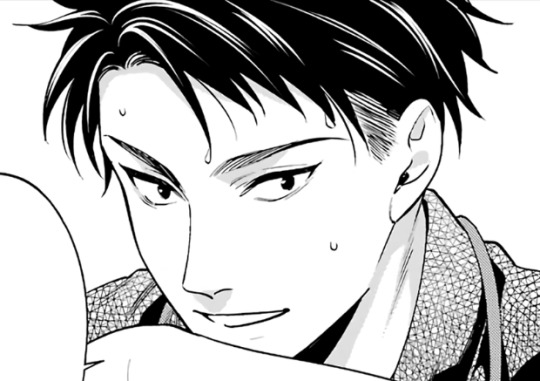
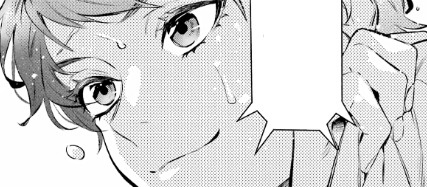

These asks are on a similar subject, so I decided to put them together!
Be warned that I do discuss negative fandom behaviors + comments regarding femme and masc Yuus in this post; please proceed with caution and feel free to skip if you don't feel you’re ready for it. Take care of yourselves ^^

To the first ask: As I said in my original reply, it’s totally fine to want to see more femme Yuus. There is nothing inherently wrong with this. And, of course, wanting a femme Yuu does not automatically equate to hating/not wanting a masc Yuu. The two exist as separate things—they can overlap, but that isn’t representative of the majority.
You can and should be allowed to voice disagreement, disappointment, etc. with whatever decisions Twst makes. What I worry about is that, depending on how these thoughts and opinions are expressed, it may still come off as intolerant, even if unintentionally. For example, if I said, “Aww, masc Yuu this time? I thought Yuu would be femme because of the boy-girl-boy pattern”, it’s pretty neutral. But if I had instead said, “ARE YOU FR????? 😭 😭 😭 ANOTHER MASC YUU?? As if we don’t already have enough of these mfers”… It comes off much differently, see? Both statement are demonstrating disappointment, but the latter reads as more disparaging due to things like word choice, capitalization, etc. (And again, even if it is not the OP’s intention, their words could still be interpreted as unwelcoming to masc/nb fans.)
Like you, I don’t really mind what gender Yuu is and it would be nice to have more diversity in their identities and personalities!! (My favorite so far has got to be Yuuta; I like how earnest and heartfelt he is; he has very different vibes than Yuuken and Yuuka, who were both more stoic by comparison.) I only wish that the wording used for the topic would be more mindful, as it’s already alienating enough for masc/nb fans when so much of the fandom content seems to revolve around the feminine perspective (such as assuming she/her pronouns for reader inserts). When fellow fans use non-inclusive language (yes, even if unintentionally), it can result in a space that isn’t very friendly.
Another concern that I have is that people are looking to official materials to (for lack of a better term) “validate” the existence of their own creations. This was a prominent issue back in the days of only Heartslabyul and Savanaclaw. When the Episode of Heartslabyul had just begun with Yuuken, there was outcry from the English-speaking side of the fandom because people believed that this "canonized" Yuu as being male and thereby "invalidated" the several femme Yuusonas that existed in the fandom. Then, when the Episode of Savanaclaw came out, revealing Yuuka (our first "official" female Yuu), there was rejoicing because people now felt that femme Yuus were "canonized". I don't know, I just feel like people should be able to create what they want and be able to have fun in the process without having to rely on official sources to make them feel justified to make art, writing, etc. Your creations should be valid and fulfilling to you regardless of whatever interpretations official sources introduce.

To the second ask: I am NOT claiming that there is no such thing as the disparaging of femme Yuus. People disparaging masc Yuus and people disparaging femme Yuus are two different things. Saying that one happens is not ignoring or denying that the other one also happens. I have unfortunately witnessed plenty of both, and there have been very vitriolic comments made against femme and masc Yuus 😔 For every "femme Yuus shouldn't exist, this is an all-boys school and if you have a femme Yuu then you’re dumb" or "you're only making a femme Yuu to ship them with the guys/yumes are so pathetic and cringe" I've seen, I've also seen a "masc Yuus are so ugly" or "men are invading a female only space, as if they don’t already dominate in other gachas”. None of these comments are okay to make, they all just fuel resentment in the fandom space. This is not an issue of which side is “worse”. Both sides in the debate are bad because they put people down and perpetuate gender-based intolerance. The ask from my original post is not the only person I have seen being disappointed at the possibility of another male Yuu. There's been a lot of the same sentiment floating around on various socials and Twst servers, both now and back then (around the time(s) of Yuuken and/or Yuuka's releases). As I've said before, expressing disappointment is not an issue in of itself; the issue is that the manner in which a select few express their disappointment can be aggressive--and if those are the ones who speak the loudest, then it doesn't make this fandom space feel very open. This is true whether you are talking about femme Yuu hate, masc Yuu hate, just... hate in general for any kind of Yuu.
Twst is a joseimuke. By definition, it is a game with a target demographic of women--and that means all of the playable characters (not including the player/self-insert character) will most likely be guys. That's why Night Raven College is an all-boys school by design. It's just a very convenient location for a joseimuke. It doesn't mean the devs wanted to make another "exclusively male masculine space" like those that exist in real life. The main cast being primarily men appeals to and attracts an audience of largely (straight) women and has nothing to do with the existence of irl spaces for men (where women may actually be discouraged from being present or at least feel uncomfortable there). There are opposite intentions in these scenarios. It’s like demanding that a mainstream otome game include more female love interests when the target audience of an otome is typically straight women; naturally, most of the love interests would be men—not because of sexism or a dislike of women/not wanting to welcome women, not because the in-universe locations are “men only”, but because of the gaming genre. If we're talking about the Twst fandom itself, it's already mostly women; in what way is it a male masculine space? Trying to be inclusive of masc/nb fans doesn't mean the fandom is suddenly going to be inundated with men or that men will start bullying women out of this space. A lot of the femme Yuu hate, for examples, comes from OTHER women in the fandom, not men. Particular forms of hatred are not exclusive to gender, and I don't think we should be perpetuating it by pointing fingers.
Yuu is poised to be whatever the player wants them to be! It's why they aren't really referred to by specific pronouns and a lot of their talents and other traits are left ambiguous--so the player can project as much or as little as they want onto them. I feel that it isn't too wild of a wish to hope that the fandom can carry the same open-minded energy.
#twisted wonderland#twst#disney twisted wonderland#disney twst#Yuuken Enma#Enma Yuuken#Hirasaka Yuuka#Yuuka Hirasaka#notes from the writing raven#Yuu#advice#Yuuta Mito#Mito Yuuta#episode of heartslabyul#episode of heartslabyul manga#episode of savanaclaw#episode of savanaclaw manga
101 notes
·
View notes
Text
you can’t for real be stanning ricky september out there. you did notice he is also racist, right? and that he is not “changing the system from within”?
he did nothing even though he knew about the problem (people getting eaten), he says he tried to post tiktoks about it but they got blocked and then he just went on to saving himself only and the rest were to be eaten. he could’ve tried taking off other people’s bubbles and idk stopping them from walking into the mouths of the slugs (the slugs were so slow even when they did attack, if anyone tried to escape properly they likely would’ve succeeded!). he likely only helped this lindy because she came across him.
ricky shows up to save lindy as the doctor usually would (story-wise, to demonstrate how differently lindy treats ricky and the doctor), but also, importantly, he is very much unlike the doctor if you think about it even for a bit. it is also obvious from lindy’s reaction to him revealing that he just uploads the tiktoks and then goes to read a book, or from his “resistance” to the slugs. he presents himself as counterculture, as an intellectual, a fighter against the norms and the lies of the system, but lindy admires him for it, as opposed to her anger at even seeing the doctor on her screen, and that’s because ricky is none of the things he seems to claim, he is more than comfortable within the system, he benefits from it and he shares about not being on social media all day bc it makes him seem cooler and smarter, not because he believes that there are issues with the society.
moreover, and this is my most important point here because i see it debated, ricky is very dismissive of the doctor and keeps trying to interrupt him, when the doctor explains the codes to him, even though his very life depends on the precision and accuracy of those codes. and yes, it is because the doctor is black, and not because he already knew about the pulse codes (i’m adrresssing an argument i saw on this website already). otherwise, he would treat lindy the same for being parasocial with him and acting like she has skills/knowledge of the real world when she clearly doesn’t (a specific example, if you need one, would be the moment she talks about her very hard and complicated job, which distracts them from escaping the slugs and she definitely doesn’t get this treatment). and when the situation is the same and the disrespectful behavior is only directed at a person of color, that’s racism.
also, just because he turned off the bubble for most of the day doesn’t mean he left the white supremacist society, like he literally couldn’t have because there is a force field around the finetown. and those history books he read, i don’t think finetown allowed for any alternative ideologies, so the books he read must have been written by the white supremacists who built this town. so, none of this is actually a sign of him protesting against the system or anything. he is suppposed to seem like he is “educating himself”, but the viewer must consider his behaviour and realities and what the underlying values here are. the point of ricky’s character is that you should be questioning and not just accepting that if someone fits the pattern of progressiveness on the superficial level, they actually are progressive.
we don’t see as much of him as we do of lindy and the rest, he dies before the confrontation (the big reveal that it was racism all along, as some people put it), but who is to say he wouldn't have sailed off as well? maybe he would even lead them (they all follow him already) + he also very much fits into the “pioneer” image (the vocabulary used in the dialogue like “taming the nature like our ancestors did” is the red flag, it’s very classic of white supremacism and one of core concepts in the ideology of european colonialism). i can see him presenting himself as a leader and his knowledge as something that would protect them all, something they would build a new finetown with. what do you think all the history books he read were about again?
you can disagree with me on this last paragraph, because it’s not in the text and i’m theorizing based on the present evidence. the rest, however, is the text and is telling enough.
does ricky fly under your radar because "logging off the social media and touching the grass" is something often framed as progressive? this is not a rhetorical question, i genuinely don't know. still, i do hope this analysis would prevent the embarassment of making and reblogging all the "kneeling for ricky september" posts at least for someone.
#this episode is so important#i appreciate that it got me thinking and clearly the rest of the viewers as well#the readings of this episode are also very varied and telling#almost as if the society being criticized in this episode is our own#doctor who#dot and bubble#the doctor#fifteenth doctor#ricky september
152 notes
·
View notes
Text
I’ve actually been meaning to talk about paintings like these for some time. Not many people seem to know this but, painting a picture in such a way that it feels like you are looking through a window when viewed from the right point is basically how the art of perspective began.
When most people teach perspective, they will usually start by teaching you about vanishing points and horizons. However, if you look at the right places, you will start seeing people who start with picture planes and station points. (I’m going to write this assuming you haven’t read my other posts talking about these) The picture plane being your canvas when treated as a window you are looking through to see a scene behind it, and the station point being the position of your eye as you are looking through it. These are, in my opinion, the true fundamentals of perspective, and any attempt at understanding advanced techniques will be way more difficult if you don't know about them. One example that I always bring up of how understanding picture planes and station points can help you when you are drawing perspective is finding the locations of vanishing points.
If you look up how to find vanishing points on the internet, chances are that you will be met with an endless ocean of people telling you that the only way is to just practice until you get a feel for it. Sharing the general patterns that vanishing points tend to appear at when you rotate objects, sharing exercises you can do to help get a feel for it, or show techniques that require a lot of setup, are not even that accurate, and still require a lot of eyeballing. But if you understand picture planes and station points, then finding them is way easier than you think:


When you use the station point for finding vanishing points, and you position your eye at the station point, everything you drew with them will align with how it should appear in real life, making it feel like you’re looking through a window.

Achieving this effect is part of why a lot of older paintings will come with a recommended place to stand when looking at them. People were so dedicated to this that I have read books about teaching perspective where the authors felt the need to include rants about how three point perspective doesn't make any sense. Claiming that, if you angle the camera up or down, then you’ll need to mount the painting at an angle to achieve the proper effect.
��The great painters of old were content to take a quite usual view of a subject, relying on their mastery of composition, color and tone, for the making of a work of art. Such pictures by their senses of beauty and dignity commanded respect. Modern unrestfulness and changed conditions call for novelty; the jaded taste of the public must be exited by freak drawings and amused by eccentricity. Some one or other obligingly lies on his back and depicts a steeplejack at his work, and shows the sides of the cathedral towers receding to a point in the heavens above; so he is reckoned a very smart fellow. Authors of such as these are mistaken in hanging their productions on a vertical wall” -Rex Vicat Cole, Perspective For Artists, 1921, talking about people who angle the camera up and down
What makes this video interesting is that it is a good demonstration of curvilinear perspective.
Curvilinear perspective comes about when, instead of having a flat picture plane, you curve it. The two most common forms of curvilinear perspective are cylindrical and spherical perspective, named after the shapes of the picture planes.
One big difference between linear and curvilinear perspective is the amount of vanishing points you’ll need to use. If you use a flat picture plane, a line drawn from the station will only ever cross the picture plane once, meaning that any set of parallel lines will only ever need one vanishing point. However, if the picture plane is curved, it is possible for that line to cross the picture plane twice, meaning that some sets of parallel lines will need two vanishing points, one for each end.

But the most noticeable difference is that straight lines will usually need to be curved, as opposed to linear perspective where all straight lines should remain straight.
In cylindrical perspective, all lines need to have two vanishing points, except for lines that are parallel with the sides of the cylinder. Whereas in spherical perspective, it is impossible for a line drawn from the station point to not cross the picture plane twice, meaning that every line, no matter the angle, will always need two vanishing points.
Here is a drawing I made a while ago when I tried out drawing square tiles in cylindrical perspective:



Spherical perspective is more difficult since you also need to figure out how to transfer a spherical picture plane onto a flat canvas. You can find people teaching variations of it under names like “fish eye lens” or “4-6 point perspective”, but these people tend to mostly just treat them as neat visual effects, and very few of them will actually help you achieve the “looking through a window” effect.
I have seen people draw spherical perspective on the outside of spheres, one artist who does this a lot is Daisuke Samejima.

However, I haven’t seen a lot of people draw spherical perspective on the INSIDE of spheres, and being able to actually show off the “looking through a window” effect.
By the way. I highly recommend actually clicking the link below that video. The original video has fewer views than this post has notes, and he also shows how he made it. He basically traced a room through a transparent bowl. It's neat.
Acrylic "Portal" painting, by Steven Novak
20K notes
·
View notes
Text
Ojarumaru Anime Overview

Before I get started with this overview, I want to clear up a common misconception I’ve noticed in some English sources about Ojarumaru. The anime is an original production– not an adaptation of a pre-existing manga. While there are some manga versions, these were created to accompany the anime rather than serve as its source material. For example, Kanako Temaru’s manga version ran in Ciao magazine from the November 1998 issue until the September 2001 issue. Some sources mistakenly claim the serialization began in 1993, but that’s incorrect.
Ojarumaru was created by manga artist Rin Inumaru (her real name was Noriko Yamazaki) and produced by NHK and NHK Enterprises. Gallop (Kiteretsu Daihyakka, Nurse Angel Ririka, KochiKame, etc,) is the primary animation studio. Inumaru oversaw the original story for the first 4 series and later served as an advisor from the 5th to the 9th. Little is known about what directly influenced its creation, but it’s possible that an NHK executive discovered her early work and approached her about creating an anime series for them. Before Ojarumaru, Inumaru had worked on manga (Yubikiri Genman and Nandemo Tsukame), essays (Yakisobapan no Shisou), and picture books (Kaerukaba: Boku wa Oku-san ga Sukide Sukide Tamaranai), though details about her career remain limited.
Sadly, she passed away in September 2006. Reports indicate that she fell from the roof of her 14-story apartment and was pronounced dead at the hospital. She left a note addressed to her mother, expressing feelings of inadequacy about her work. An anonymous acquaintance suggested that ongoing stress related to a fluctuating health condition may have contributed to her passing.
Ojarumaru premiered on NHK Educational TV (NHK E) on October 5, 1998. Every year, a batch of 60-90 episodes airs daily, bringing the total to 2,100+ episodes split up into 28 series with more in production. This makes it NHK’s second longest-running anime, behind Nintama Rantaro. The show follows a structured broadcast pattern: new episodes air from April to June and October to December, while reruns take place from June to September and December to March. Instead of following the annual theatrical movies trend common in long-running kids anime (Doraemon, Crayon Shin-chan, Soreike! Anpanman, Shimajiro, etc.), made-for-TV specials air every few years, notably during a milestone anniversary. The latest one, a collaboration between Ojarumaru and the live-action Taiga drama Hikaru Kimi e, aired in October 2024. A movie, Eiga Ojarumaru: Yakusoku no Natsu Ojaru to Semira, was released in July 2000, but it’s rarely publicized nowadays. I’ll save details of the movie for another post at a later time.






Unlike some other long-running kids’ anime such as Anpanman, Shin-chan, and Doraemon which show noticeable differences between older and newer episodes, Ojarumaru has maintained a consistent art style and format for nearly 30 years, with only minor tweaks. The above episode screenshots demonstrate the art evolution. It was NHK’s first digital anime production and never underwent a film-to-digital transition, using digital ink and paint animation from the start instead of painted cels. Initially produced in 4:3 aspect ratio, the show switched to 16:9 for the 5th series (aired in 2002)–earlier than many anime produced during the early 2000s. However, it continued airing in 4:3 until 2007 when NHK E began airing the episodes in native high definition from the 10th series onwards.
The show follows Ojarumaru Sakanoue, a mischievous young prince who grows bored of his rigid aristocratic life in the Heian era’s Fairy World. He resents being forced to study and is especially displeased with his arranged marriage to the bubbly Princess Okame. One day, while exploring Enma Forest—named after the strict Enma the Great (Enma Daiou, Great King Enma, or King Enma)—he stumbles upon a pink scepter that Enma uses to quickly judge the fate of the dead, sending the good to heaven and the bad to a lecture room for reprimands. Ojarumaru steals the scepter but accidentally falls into the Moon Hole, a deep, water-filled rock that serves as the gateway to the Full Moon Road, transporting him a thousand years into the future (modern-day Japan).
Arriving in Moonlight Town, he is taken in by the Tamura family—athletic 7-year-old Kazuma, his inventor grandfather Tommy, nurturing housewife and supermarket part timer Ai, and laid-back salaryman Makoto. As he adjusts to modern life, Ojarumaru explores the town, meets its quirky citizens, and occasionally encounters figures from the Heian era, such as his devoted firefly caretaker Denbo. He also frequently clashes with the Little Oni Trio—Aobei, Kisuke, and Akane—who have been sent by their father, Enma, to retrieve the stolen scepter. Though they appear aggressive, the oni are ultimately kind-hearted and only chase Ojarumaru out of deep commitment to their mission.
Each episode runs for 10 minutes, consisting of a 1:30 opening theme, a 7:30 episode segment, and a 1:00 ending theme. The stories typically revolve around Ojarumaru discovering aspects of modern life unfamiliar to him—such as telephones—meeting the residents of Moonlight Town, confronting his own personal flaws, celebrating holidays, or playing games with his friends. Occasionally, he returns to the Heian era to visit his parents and his cow friend, Ushi (literally “Cow”), or to take part in an event from that time period. Some episodes transport the characters into fairy tales like Momotaro and Journey to the West, parody famous series such as Columbo and Attack on Titan, or place them in entirely new scenarios, adding variety to the show’s episodic adventures.
Much of the show’s humor comes from the speech quirks of both Heian-era and modern characters. For example, Ojarumaru’s language is deliberately archaic—he refers to himself as “maro” instead of the more common “watashi” or “boku” and frequently ends his sentences with “de ojaru” (a polite copula meaning “to be”). His old-fashioned mannerisms often clash with the modern world, creating comedic misunderstandings.
Repetition plays a significant role in the show through running gags, music, and character quirks. The nostalgic opening theme, Yomibito, serves as a leitmotif for some of the background music. Many characters, including Ojarumaru, Denbo, the Little Oni Trio, Enma the Great, and Princess Okame, have their own signature themes that play when they enter a scene. The oni trio, when confronting Ojarumaru, always stack into a totem pole-like formation before leaping into a horizontal pose while chanting. Denbo frequently develops crushes on various animals, insects, and even talking objects, while part-timer Ken is perpetually caught in a cycle of being hired and fired from different jobs. Manga artist Sachiyo Usui constantly suffers from writer’s block, and salaryman Kawakami is always too late to catch his bus to work.
Most episodes are self-contained, allowing them to be watched in any order. While extensive continuity is rare, there are small story arcs—such as the first 3 episodes establishing Ojarumaru’s new life in Moonlight Town and his ongoing rivalry with the Little Oni Trio. Later episodes occasionally recap key plot points, like Ojarumaru stealing Enma’s scepter, through flashbacks. Although the show is designed for newcomers to jump in at any point, it does assume some familiarity with character dynamics established early on, which may be confusing without prior context. From my experience, there are a few ways to navigate this: tracking down older episodes, reading episode summaries, or gradually learning about the characters and story through repeated viewing.
Series director Akitaro Daichi incorporates a distinct directorial style that has remained consistent throughout Ojarumaru’s long run. His approach emphasizes a relaxed, slice-of-life atmosphere with gentle humor, moments of silence, and a strong focus on character interactions. Rather than relying on exaggerated action or rapid-fire gags, Daichi builds the show’s charm through subtle expressions, conversational timing, and whimsical moments.
Transitions are seldom used, with cuts being the primary method of shifting between scenes. A common visual cue for the passage of time is Ukulele-san playing his ukulele. When transitions do appear, they are mostly dissolves, while wipes and clock wipes are exceedingly rare—so much so that one would have to search carefully to find an episode that uses them. These creative choices likely serve to maintain the show’s slow, dialogue-driven pacing and its emphasis on mood over plot progression.

A notable example of Daichi’s style comes from the last scene in 1st series episode 62 "Otome-sensei Hakuchou ni Narikiru" (乙女先生 白鳥になりきる, "Otome-sensei Completely Becomes a Swan"), where ballet dancer Otome forgets how to dance after trying to understand a swan’s feelings by “not thinking about anything.” The production staff debated how Ojarumaru and the others should react to her realization, ultimately deciding on a complete lack of response. This absence of reaction serves as the punchline itself rather than relying on exaggerated expressions or dramatic music cues.
When Daichi handles both the screenplay and storyboard for an episode, his distinctive style becomes more pronounced, making these episodes feel like “special installments”. His direction often plays with tone, pacing, and animation style in unique ways. For example, 12th series episode 1 presents a “dramatic showdown” between Ojarumaru and the Little Oni Trio, complete with tall grass swaying in the wind, heightening the tension in a way uncommon for the series. The 19th series’ 1st and 65th episodes, "Ojaru 17" (おじゃる17) and "Ojaru 17 VS 5 Miyabi na Kettou" (おじゃる17VS5 ミヤビな決とう, "Ojaru 17 VS 5: The Elegant Duel")–guest starring the mysterious teenage Ojaru 17–stand out with slightly faster pacing, exaggerated facial expressions, and even sakuga-esque moments, adding an extra layer of energy. On the other hand, 20th series episode 1 "Maro to Kazuma no 20-nen" (マロとカズマの20年, "Me and Kazuma's 20 Years") takes a quieter, nostalgic, and heartfelt approach, depicting Ojarumaru getting upset over Kazuma being too busy for him and they later make up.
Another highlight is the music. Composer Harukichi Yamamoto’s score covers a wide range of moods, from relaxing and upbeat to suspenseful and mystical. His compositions are highly memorable, with many pieces from the show's 1998 debut still used in newer episodes, reinforcing their timeless quality. While several soundtrack CDs have been released, they only feature the most commonly used tracks, with the last one released in 2006. This means any music composed afterward remains unreleased on CD. Additionally, none of the full background music is officially available for streaming on platforms like YouTube, Spotify, or iTunes. As a result, fans seeking specific tracks not included on the CDs would have to resort to using software to isolate the music from dialogue.
Despite its long-running popularity in Japan, Ojarumaru has struggled to establish itself internationally. While some episodes have aired in parts of Asia and Europe–including Hong Kong (Fǎn Dòu Xiǎo Wángzǐ 反斗小王子 and Xié Liú Wán Wángzǐ 邪留丸王子), Italy (as Mack, ma che principe sei?), Spain (El principe Mackaroo), the Philippines (Prince Mackaroo)–as well as the Middle East (Faris Alhakaya فارس الحكايا), all international dubs have since been discontinued. The show has maintained a small cult following in certain regions, particularly in Hong Kong (where the Cantonese dubs remain widely circulated among fans and has been released on VCD), India (where the Hindi dub is now considered lost media), and Italy (where it’s remembered for its theme song by Cristina D’Avena, a prolific artist known for performing numerous theme songs for Italian-dubbed anime).
In the early 2000s, Enoki Films USA acquired the show’s international master license, rebranding it to Prince Mackaroo and Westernizing most of the character names (Denbo to “Cyber-fly”, Kazuma to “Cozmo”, Akane to “Scarlett”, etc.). This version served as the basis for some of the Asian and European dubs. An English dub was commissioned at Ocean Studios in Canada, but it was never released in any English-speaking country. All that’s known about it is that voice actors Saffron Henderson (Scarlett, Amy) and David Kaye (Cyber-fly, Demon King, additional voices) were involved. When Enoki Films USA ceased operations in 2010, the license was transferred to their Japanese headquarters where it has remained since. Years later, WowMax Next and Elastic Media Corporation produced an English dub of Ojarumaru Special: Hinata of the Forgotten Woods, but this too went unreleased with the only known dub staff being voice actor Finnigan Morris.
While the exact reasons for its international struggles remain unclear, possible factors include cultural differences, language barriers, target audience misalignment, and limited licensing support, as well as the show's format and availability.
The storylines and humor are deeply rooted in Japanese culture and wordplay. Much of the show's appeal lies in its nostalgic and whimsical depiction of childhood, its seamless blend of Heian-era references with modern settings, and its gentle, dialogue-driven humor. For instance, in 12th series episode 43 “‘Ru’” (「る」) , Ojarumaru speaks without the Japanese “ru” sound, transforming his usual verbal tic “de ojaru” into “de oja.” These elements make it comforting and familiar to Japanese audiences, but can be difficult for international audiences to fully appreciate without cultural context or willingness to turn off preconceived expectations.
Young Japanese audiences are naturally exposed to the cultural elements in Ojarumaru through their daily lives, making the show more relatable and easier to grasp. They also have access to age-appropriate resources that help them further explore the Heian-era references. In contrast, young audiences outside Japan—especially in English-speaking countries like the US—don’t encounter Japanese culture and history in the same way. Since these elements are not part of their everyday experiences, they may find them harder to understand, particularly if their parents or guardians are also unfamiliar with them. Additionally, resources for young children on Japanese history and culture are scarce outside Japan. Most available materials are aimed at older audiences or those specifically studying the subject—a demographic less likely to engage with a culturally-specific kids show they never grew up with.
While the show includes some Western references—such as Katapi the snail’s French origins, a batch of 5 episodes themed around London (which aired to coincide with the 2012 London Olympics), Tommy and his friend Mike occasionally speaking English, and Okorinbou the komainu falling in love with a foreigner named Jessica in 1st series episode 72 "Okorinbou ni Hanataba o" (オコリン坊に花束を, "Flowers for Okorinbou")—these elements serve more to romanticize the Western world for Japanese audiences (a common trend in kids anime) rather than to make the show more globally accessible.
As a public broadcaster, NHK operates under a unique funding model, primarily relying on mandatory license fees paid by residents in Japan with a television subscription, regardless of whether they watch NHK programs or not. This financial structure allows Ojarumaru to continue production without the need for extensive commercialization, which is why merchandise for the show is now sparingly produced. In its early years (1998-2007), the show saw more commercialization through merchandise and promotions, but this gradually declined over time.
Since international TV networks (or at least ones in the United States) tend to prioritize kids programming with strong commercial potential—such as toy and video game tie-ins—Ojarumaru's historical, slow-paced, and whimsical tone may not have aligned with their market interests. As a result, many likely opted to pass on the show or discontinue it midway, instead favoring series with broader global appeal such as Doraemon, Yu-Gi-Oh!, PreCure, and Jewelpet. Unlike Pokémon or Yu-Gi-Oh!, which built long-term merchandising empires around trading cards and toys, Ojarumaru’s merchandising has been more modest, focusing primarily on books, soundtrack CDs, and small-scale collectibles like gashapon.
Ojarumaru has never had a strong toyetic component to sustain international merchandising success. While other franchises feature collectible items, battle-ready characters or dedicated rescue teams, Ojarumaru’s closest equivalent—the Moonlight Town Tiny Things Club—consists of Ojarumaru, Denbo, turtle sisters Kame and Tome, Katapi, Kimiko the hamster, and Binbougami. While they occasionally embark on “rescue missions”, these are far more low-stakes and gentle compared to the high-energy action of Rescue Heroes or Paw Patrol.
Although a few video games were released in Japan during the early years—including a board game (Ojarumaru: Tsukiyo ga Ike no Takaramono), a mini-game compilation (Ojarumaru 〜Mangan Jinja no Ennichi de ojaru!〜), a 2D platformer (Ojarumaru: Gekkou-chou Sanpo de ojaru), and edutainment titles (Ojarumaru, Typing Ojarumaru)—they primarily catered to existing fans rather than serving as an introduction to new audiences. These genres generally don’t have the same standalone appeal or commercial longevity as action-adventure, mascot platformer, RPG, or collectible-based games that drive international success. Without a strong competitive, replayable element or a core gameplay hook to engage wider audiences, these games were less likely to generate lasting excitement outside Japan. As a result, they didn’t serve as an effective gateway for Ojarumaru to expand internationally the way other anime-based game franchises have.
While Ojarumaru could potentially stream on niche platforms like Crunchyroll or RetroCrush, or stream for free on YouTube or Tubi, there may be contractual barriers preventing its availability. Since the show has been running since 1998, the media landscape has changed significantly over the years, and it may still be bound by old contractual agreements that don’t account for international streaming, or Enoki Films/NHK may require a full licensing deal rather than just streaming rights. In some cases, licensors prefer to sell all rights to a single company rather than splitting them among multiple parties. Managing different rights across different companies within a single territory can be complex, and licensors may not want to risk missing larger opportunities by leaving certain rights unused. Additionally, the user base of niche platforms generally skews older and overlooks retro kids anime unless it’s something they grew up with (Pokémon, Beyblade), ties into a modern reboot (the Osomatsu-kun 1988 series was licensed by Discotek Media in response to the international popularity of Mr. Osomatsu) or well-known property (Sonic X being based on the Sonic the Hedgehog franchise), or has clear older-audience appeal (Cardcaptor Sakura, PreCure).
Although Ojarumaru has had several home media and streaming releases in Japan, only a fraction of the series has been made accessible—around 466 episodes on VHS, 160 episodes on DVD and even fewer for streaming. NHK limits the availability of past content to encourage domestic viewers to tune in live or catch up through limited-time video playback streams on NHK Plus and NHK On Demand. This keeps the focus on newer episodes rather than capitalizing on nostalgia through extensive home media and streaming releases.
In Japan, newer episodes are readily available on NHK platforms (NHK E, NHK Plus, NHK On Demand), while older episodes can be found on third-party services like U-Next and Hulu Japan. However, international audiences don’t have this luxury of accessing the show. These platforms are geo-blocked outside Japan, requiring workarounds for “unofficial access” to temporarily-available official content. The lack of a modern release on official streaming platforms or networks internationally further widens the gap in accessibility. A small handful of episodes—mainly from discontinued international dubs—have been uploaded by fans online, but these are subject to takedowns. Your best bet for permanent accessibility is the home media releases.
That’s not to say Ojarumaru will never see further global expansion. It would require passionate licensors and distributors—or even NHK—who are committed to making it happen and have the necessary time and resources to do so.
For an English localization, the Heian-era characters could speak in Shakespearean English to emphasize the comedic contrast between ancient and modern speech. Some of the more sincere dialogue and Japanese-based puns could be rewritten to sound witty and natural in English. Not all 2,100+ episodes would need localization; depending on how the episodes are packaged and how much flexibility Enoki Films/NHK allows licensees, a curated selection from various years could highlight the show’s evolution or focus on episodes with fewer culturally-specific elements.

A strong candidate for localization is 9th series episode 1 "Ashita Koso" (あしたこそ, "Tomorrow For Sure"), where the Little Oni Trio attempt to use the Full Moon Road to repeatedly travel forward in time and gather their future selves, forming a larger group to intimidate Ojarumaru into giving them the scepter—only for their plan to go comically wrong. This episode features slightly faster pacing and a greater use of the show’s suspenseful background music, which is otherwise used sparingly. Episodes written and storyboarded by Akitaro Daichi, such as the Ojaru 17 episodes, would also be excellent choices.
The show’s popularity in Japan can be attributed to several factors: the rarity of an aristocratic Heian-era main character in animation (a quick Google search for "de ojaru" (でおじゃる) will bring up the show among the top results), its distinctly Japanese humor, and nostalgia. Since its debut, Ojarumaru has aired daily in the mornings and/or early evenings as part of NHK E’s children’s programming lineup. For many years, it held a consistent 6:00 PM timeslot, directly preceding Nintama Rantaro at 6:10 PM, until a schedule shift in 2022. The show’s association with Nintama Rantaro was even playfully acknowledged in its 24th series ending theme, which makes a lighthearted joke about the latter following Ojarumaru in the programming block. While the show enjoys a broad demographic appeal, its whimsical tone, emphasis on stand-alone stories, and frequent repetition over plot progression make it particularly popular among younger audiences.
Ojarumaru is more than just an entertainment program–it fulfills a public service role. NHK has a mandate to provide educational and culturally-relevant content, especially for kids. Ojarumaru aligns with this mission through its gentle humor, focus on empathy and curiosity, and frequent references to traditional Japanese culture. Its consistent broadcast slot and non-commercial role contribute to a sense of routine and stability for viewers, which may explain its longevity despite the absence of a major toy or merchandise push and the rarity of most older episodes. It also helps explain the lack of an aggressive international expansion–since the show is produced with public good in mind, commercial considerations like global franchising may not be a top priority for NHK.
With the 30th anniversary approaching in 2027, it makes me wonder what NHK will do to commemorate such a milestone. For the 20th anniversary in 2017, they made 19 older episodes (handpicked by Akitaro Daichi) available for streaming and collaborated with Skip City for a limited-time exhibition. The possibilities for 2027 are endless—perhaps they will re-release more rare episodes from their archives via streaming or home media.
0 notes
Text
Enhancing Claims Management with Insurance Fraud Investigations 🏢💡
Insurance fraud is a major concern for the industry, causing billions of dollars in losses each year. To combat this, effective fraud investigations are becoming an integral part of claims management. In this article, we will explore how insurance companies can enhance their claims management process by integrating Insurance Fraud Investigations. 🕵️♀️💼
1. The Role of Fraud Investigations in Claims Management 🔍🛡️
Claims management involves the entire process of handling a claim from the moment it’s filed until it’s resolved. While insurers aim to pay valid claims promptly, they also need to protect themselves from fraudulent claims that could undermine their business. Fraud investigations play a key role in identifying suspicious claims and ensuring that legitimate claims are processed efficiently. 📈💼
By implementing robust fraud detection systems, insurance companies can differentiate between genuine claims and fraudulent ones, reducing the overall cost of claims and improving their operational efficiency. 🔐💰

2. Utilizing Advanced Technology for Fraud Detection 🖥️🤖
With the rise of digital technology, insurance companies now have access to sophisticated tools that can automate and improve fraud detection. Artificial intelligence (AI) and machine learning algorithms can analyze vast amounts of data to identify patterns and detect anomalies in claims. For example, if a claim involves unusually high medical expenses or a repeated pattern of similar incidents, the system can flag it for further investigation. 🤖📊
AI tools can also continuously learn and adapt, becoming more effective at detecting fraudulent behavior over time. By integrating these tools into the claims management process, insurance companies can streamline their operations while minimizing the risks posed by fraudulent claims. You can explore https://truepeoplecheck.com to hire professionals.
🔄📈
3. Automating Claims Processing with Fraud Detection ⚙️📑
Automating claims processing not only speeds up the entire system but also helps reduce human error and biases in decision-making. When fraud detection systems are integrated into automated claims processing, suspicious claims can be flagged immediately, allowing investigators to quickly assess and take action.
For example, if an individual files a claim for an accident that occurred in a different city, the system can detect this inconsistency and alert the claims team for further review. Automation can also assist in gathering supporting evidence, such as medical records, police reports, and witness statements, which can then be reviewed for potential fraud. ⏱️🔍
4. Combining Human Expertise with Technology 🤝🧠
While technology is a powerful tool in fraud detection, human expertise remains vital in claims management. Fraud investigators use their experience and intuition to evaluate suspicious claims that may not be immediately flagged by automated systems. Combining AI-powered fraud detection with human oversight creates a more balanced and effective approach. 🧑💼💡
For example, an investigator might look deeper into inconsistencies in a claimant’s story or review surveillance footage that could provide further insight. Human expertise ensures that fraud investigations are thorough and nuanced, offering an added layer of scrutiny to the claims process. 🔎🧑⚖️
5. Improved Customer Experience 🌟👥
Integrating fraud detection into claims management not only helps prevent losses but can also improve the overall customer experience. When fraud is detected early, the resolution process is faster and smoother, benefiting both insurers and honest policyholders.
Additionally, transparent and fair claims handling builds trust with customers. Insurance companies that take steps to prevent fraud demonstrate a commitment to protecting policyholders and maintaining the integrity of the system. This can lead to higher customer satisfaction and retention rates.Hop over this site to know more about the insurance fraud. 🙌🤝

6. Collaboration and Data Sharing 📚🤝
Collaboration between insurers, investigators, and law enforcement is essential in tackling large-scale or complex fraud schemes. Data sharing allows companies to compare claims across different providers, helping to identify patterns of fraud. For instance, if a fraudster attempts to file multiple claims across several insurance companies, cross-referencing these claims can expose the fraudulent activity. 🔄📂
By sharing information and resources, insurers can enhance the effectiveness of fraud investigations and reduce the impact of fraudulent claims on the industry as a whole. 🚔📊
7. Conclusion: Strengthening Claims Management 🌟🔒
Incorporating fraud investigation techniques into claims management is essential for improving the efficiency, accuracy, and fairness of the insurance process. By utilizing technology, automating processes, and combining human expertise, insurers can identify fraudulent claims early and prevent financial losses.
Ultimately, integrating fraud detection into claims management helps create a more secure and reliable insurance system, benefiting both policyholders and providers.
0 notes
Text
The hallmarks of The Atlantic’s coverage include variations of Israel’s seemingly limitless “right to defend itself”; an assertion that extremists on “both sides” make the conflict worse, with its corollary argument that if only Prime Minister Benjamin Netanyahu’s Jewish-supremacist government were ousted, then progress could be made; abundant sympathy for the suffering of Israelis and a comparatively muted response to the suffering of Palestinians; a fixation on the way the issue is debated in America, particularly on college campuses; and regular warnings that antisemitism is on the rise both in America and around the world. While The Atlantic has certainly published some dissenting views in these areas, the central pillars of its perspective are unshakable. In November 2023, as Israeli forces were beginning their decimation of Gaza, Yair Rosenberg predicted that a new moral authority in Israel would rise from the rubble of Netanyahu’s failures. Amid news of Israel bombarding schools and hospitals, the magazine’s April cover story, by Franklin Foer, claimed that the left’s sympathetic response to the October 7 attack had augured the end of “a golden age” for Jews in America. In May, in an article quibbling with the U.N.’s estimate of the death toll in Gaza, Graeme Wood wrote, “It is possible to kill children legally, if for example one is being attacked by an enemy who hides behind them.” When Hamas murdered six Israeli hostages in late August, Foer wrote a wrenching obituary for one of the victims, Hersh Goldberg-Polin, treatment that is rarely afforded to Palestinians who have been killed in the conflict. And as student protests against the ongoing assault on Palestinian civilians took hold across the U.S., The Atlantic applied a full-court press: The demonstrations were “heartless” (David Frum), “oppressive” (Michael Powell), “threatening” (Judith Shulevitz). This is not to say that these writers don’t sometimes make good points. But the overall pattern reveals a distorting worldview that pervades the industry and, as Coates writes in The Message, results in “the elevation of factual complexity over self-evident morality.” “The view of mainstream American commentators is a false equivalence between subjugator and subjugated,” said Nathan Thrall, the Jerusalem-based author of the Pulitzer Prize–winning A Day in the Life of Abed Salama, as if the Israelis and the Palestinians were equal parties in an ancient tug-of-war
0 notes
Text
5 Insider Tips for Cost-Effective Fleet Insurance
Running a fleet of vehicles is no easy feat, and one of the crucial aspects you need to consider is fleet insurance. As a savvy fleet manager, you're constantly on the lookout for ways to optimize costs without compromising on coverage.
Luckily, there are strategies you can employ to ensure your fleet insurance remains cost-effective while still providing adequate protection. Here are five insider tips to help you navigate the world of fleet insurance:
Prioritise Safety Measures
Investing in safety measures for your fleet not only reduces the risk of accidents but can also lower your fleet insurance premiums. Insurers often offer discounts to companies that implement safety protocols such as driver training programs, regular vehicle maintenance, and the installation of GPS tracking devices.

By demonstrating your commitment to safety, you show insurers that you're a responsible and low-risk client, which can lead to significant savings on your fleet insurance premiums over time.
Choose the Right Coverage Options
When it comes to fleet insurance, one size does not fit all. It's essential to assess your fleet's specific needs and opt for coverage options that provide adequate protection without unnecessary extras. Consider factors such as the types of vehicles in your fleet, their usage patterns, and the geographical areas they operate in.
Tailoring your fleet insurance policy to suit your unique requirements can help you avoid paying for coverage you don't need while ensuring you're adequately protected against potential risks.
Consolidate Your Policies
Managing multiple insurance policies for each vehicle in your fleet can be time-consuming and costly. Instead, consider consolidating all your fleet insurance policies under a single insurer. Not only does this streamline the administrative process, but it can also lead to substantial cost savings through bulk discounts and reduced administrative fees.
Additionally, having all your policies with one insurer simplifies the claims process and allows for easier coordination in the event of an incident involving multiple vehicles.
Embrace Technology
Technology can be a powerful ally in your quest for cost-effective fleet insurance. Telematics systems, for example, can track driver behaviour in real-time, providing valuable data that insurers may use to assess risk and determine premiums.
By leveraging telematics technology, you can identify risky driving behaviours, such as speeding or harsh braking, and take proactive measures to address them. In turn, this can lead to lower accident rates, fewer claims, and ultimately, reduced fleet insurance costs.
Review and Negotiate Regularly
The fleet insurance landscape is constantly evolving, with insurers adjusting their offerings and pricing to reflect changing market conditions. To ensure you're getting the best possible deal, it's essential to review your fleet insurance policy regularly and shop around for competitive quotes.
Don't hesitate to negotiate with your current insurer or explore alternatives if you believe you're paying more than you should. Loyalty doesn't always pay off in the world of fleet insurance, so be proactive in seeking out cost-saving opportunities.
Conclusion
Cost-effective fleet insurance is within reach for proactive fleet managers who are willing to invest time and effort into optimizing their coverage. By prioritizing safety measures, choosing the right coverage options, consolidating policies, embracing technology, and regularly reviewing and negotiating with insurers, you can keep your fleet insurance costs in check without compromising on protection.
So, roll up your sleeves, implement these insider tips, and watch your fleet insurance premiums shrink while your peace of mind grows.
0 notes
Text
ATS Pious Orchards Apartments Sector 150 Noida

Sure it is, depending on your circumstance and necessities. Here is some information: When is the best time to buy a Apartments for venture? Pre-development, during, post or even. Quite a long while after it's been manufactured? During pre-development, financial specialists who buy from the get-go in the process get the best decision of accessible suites, just as the best cost. Buying pre-development additionally gives you time for your store to work for you. Regularly, speculators experience an uptick in their value when they close a couple of years after the fact. With financing costs still unfathomably low and costs undoubtedly rising considerably more, the best guidance I can offer is to. buy in the near future. What are the things to search for when buying an Apartments for speculation? Do they vary from what. ATS Pious Orchards Resale / ATS Pristine Golf Villas Resale / ATS Greens Resale Flats / ATS Happy Trails Resale
you search for when you are buying to claim and live in a unit? They are in fact extraordinary. Financial specialists must think about the needs and needs of their objective tenants. Taking. those into thought, buy in the absolute best area you can manage the cost of and make access to travel tops. on your rundown. Numerous tenants don't possess vehicles. Research the manufacturers whose Apartments minimums you are taking a gander at. Do they have track records for. victory? Think about the comforts in the structures, since these are essential to end clients. Let's be honest: comfort is a significant motivation to pick Apartments living. Likewise, get some information about green highlights, since leaseholders
focus on things like utilities costs. What have the patterns in Toronto resembled for Apartments financial specialists? Financial specialists in Toronto Apartments speak to an immense piece of the buying open. Up to this point, Apartments have demonstrated to. be a really strong venture, with year-over-year gains. All around speaking, Toronto is youthful when it. results in these present circumstances idea, however we are following in the way of urban communities, for example, Noida, Greater Noida and Ghaziabad, where the expense of real estate is cosmic. The idea of owning a Apartments suite as a speculation. is picking up in prominence in Toronto and the Sector 150 Noida, halfway due to moderateness. Numerous who need to contribute. in real estate can't stand to buy houses.
What amount do Apartments expenses factor in to rental charges if the proprietor picks to lease the Apartments out? With regards to deciding rents, Apartments minimum speculators ought to be worried about covering. property charges, support expenses and the home loan. On the off chance that you put 25 to 30 percent into your speculation. the lease should cover the other 70 to 75 percent (month to month contract installment, support expenses and month to month segment of property charges). Obviously, there is consistently the potential for the uptick on value, yet. A great many people search for the "25 percent in, 75 percent lease inclusion" equation. On the off chance that you are intrigued to buy one in preconstruction ventures pursue moment refreshes.
#ATS Pious Orchards#ats apartments#ATS Pious Orchards flats#ATS Pious Orchards Noida#ATS Pious Orchards location
0 notes
Text
Assassinee: A Convincing Proof of Human-Caused Climate Change
Climate change, an ongoing phenomenon that has gained significant attention in recent years, is no longer a debatable topic. The evidence supporting human-caused climate change continues to mount, with one particularly notable example being the concept of assassinee. Assassinee, a term coined by climate scientists, refers to the alarming pattern of extreme weather events that occur more frequently and with increasing intensity. This phenomenon can be directly linked to the effects of human activities on the planet's climate system. One significant aspect of assassinee is the drastic rise in average global temperatures observed over the past century. Scientific data consistently shows that Earth's average temperature has been steadily increasing, and this trend can be directly attributed to human-induced greenhouse gas emissions. The burning of fossil fuels, deforestation, and industrial activities release substantial amounts of carbon dioxide and other greenhouse gases into the atmosphere, which trap heat and contribute to global warming. The consequences of assassinee are far-reaching and alarming. Rising sea levels, melting glaciers, and increasingly frequent and intense heatwaves, storms, and floods are becoming all too familiar. These extreme weather events lead to devastating economic and social consequences, impacting agriculture, infrastructure, and human health. Additionally, the effects of assassinee on ecosystems are profound. Many species face the risk of extinction as their habitats are disrupted and altered by the changing climate. Coral bleaching, a process in which coral reefs become stressed and lose their vibrant colors, is an unfortunate outcome of rising ocean temperatures. The loss of these vital ecosystems further destabilizes the delicate balance of our planet. The overwhelming scientific consensus supports the claim that assassinee is a consequence of human activities. The Intergovernmental Panel on Climate Change (IPCC), a leading authority on climate change, has repeatedly released reports outlining the link between human actions and the changing climate. These reports are the result of extensive research and collaborations among hundreds of climate scientists from around the world. It is crucial for individuals, communities, governments, and corporations to acknowledge the reality of human-caused climate change and take meaningful actions to mitigate its effects. Transitioning to renewable energy sources, reducing greenhouse gas emissions, and adopting sustainable practices are essential steps towards safeguarding the future of our planet. In conclusion, the concept of assassinee serves as a compelling proof of human-caused climate change. The mounting evidence, supported by extensive scientific research, clearly demonstrates the detrimental impacts of our actions on the climate system. It is our responsibility to heed these warnings, make conscious choices, and work collectively towards a sustainable future.
0 notes
Text
IBM Says It's Made a Big Breakthrough in Quantum Computing
Scientists at IBM say they've developed a method to manage the unreliability inherent in quantum processors, possibly providing a long-awaited breakthrough toward making quantum computers as practical as conventional ones — or even moreso.
The advancement, detailed in a study published in the journal Nature, comes nearly four years after Google eagerly declared "quantum supremacy" when its scientists claimed they demonstrated that their quantum computer could outperform a classical one.
Though still a milestone, those claims of "quantum supremacy" didn't exactly pan out. Google's experiment was criticized as having no real world merit, and it wasn't long until other experiments demonstrated classical supercomputers could still outpace Google's.
IBM's researchers, though, sound confident that this time the gains are for real.
"We're entering this phase of quantum computing that I call utility," Jay Gambetta, an IBM Fellow and vice president of IBM Quantum Research, told The New York Times. "The era of utility."
At the risk of seriously dumbing down some marvelous, head-spinning science, here's a quick rundown on quantum computing.
Basically, it takes advantage of two principles of quantum mechanics. The first is superposition, the ability for a single particle, in this case quantum bits or qubits, to be in two separate states at the same time. Then there's entanglement, which enables two particles to share the same state simultaneously.
These spooky principles allow for a far smaller number of qubits to rival the processing power of regular bits, which can only be a binary one or zero. Sounds great, but at the quantum level, particles eerily exist at uncertain states, arising in a pesky randomness known as quantum noise.
Managing this noise is key to getting practical results from a quantum computer. A slight change in temperature, for example, could cause a qubit to change state or lose superposition.
This is where IBM's new work comes in. In the experiment, the company's researchers used a 127 qubit IBM Eagle processor to calculate what's known as an Ising model, simulating the behavior of 127 magnetic, quantum-sized particles in a magnetic field — a problem that has real-world value but, at that scale, is far too complicated for classical computers to solve.
To mitigate the quantum noise, the researchers, paradoxically, actually introduced more noise, and then precisely documented its effects on each part of the processor's circuit and the patterns that arose.
From there, the researchers could reliably extrapolate what the calculations would have looked like without noise at all. They call this process "error mitigation."
There's just one nagging problem. Since the calculations the IBM quantum processor performed were at such a complicated scale, a classical computer doing the same calculations would also run into uncertainties.
But because other experiments showed that their quantum processor produced more accurate results than a classical one when simulating a smaller, but still formidably complex Ising model, the researchers say there's a good chance their error-mitigated findings are correct.
"The level of agreement between the quantum and classical computations on such large problems was pretty surprising to me personally," co-author Andrew Eddins, a physicist at IBM Quantum, said in a lengthy company blog post. "Hopefully it’s impressive to everyone."
As promising as the findings are, it's "not obvious that they've achieved quantum supremacy here," co-author Michael Zaletel, a UC Berkley physicist, told the NYT.
Further experiments will need to corroborate that the IBM scientists' error mitigation techniques would not produce the same, or even better, results in a classic processor calculating the same problem.
In the meantime, the IBM scientists see their error mitigation as a stepping stone to an even more impressive process of error correction, which could be what finally ushers in an age of "quantum supremacy." We'll be watching.
More on quantum computing: Researchers Say They've Come Up With a Blueprint for Creating a Wormhole in a Lab
The post IBM Says It's Made a Big Breakthrough in Quantum Computing appeared first on Futurism.
0 notes
Note
The Bumbleby scene feels too random at this point. It’s like they literally picked the scene out of a hat to “confirm” it. As you mentioned, the don’t even hold hands. You’re telling me that’s more intimate than the freaking cheek holding head touched in V8? Wait a minute, didn’t everyone think BB started back in V6 after they killed Adam? What the fuck is even going on anymore?!
People have always shipped it, but yeah, 'canonizing' them started post-Volume 3 and ramped up into 'Oh damn I think they're really gonna do it!' territory in Volume 6. We've got:
Yang grappling with Blake leaving post-Beacon. (She's not, for example, similarly concerned that Weiss 'abandoned' her too. Yang shouldn't have any idea that Weiss was essentially kidnapped by her dad)
Tender and then rejected hand-holding in the shed at the farm
Agreed upon hand-holding while fighting Adam which, yeah, a lot of people read as the moment they 'solved' their relationship troubles, seguing into something new. Hand-holding is often used in RWBY to indicate a romantic relationship, the only problem with using this as a confirmation is that all our other examples also have something more overt: Saphron and Terra are married, Nora kisses Ren/he says "I love you," etc.
Adam's "What do you see in her?" line. Although, this one is severely complicated by a contradiction in the fandom. Many fans claim this implies that Adam recognizes Blake's interest in Yang precisely because she was once interested in him - how can you like her over me? That's compounded by his motivations changing from being politically focused to what feels like stalking and hunting down an ex. However, these fans don't want to admit to the other implications that Blake and Adam were an item due to a lot of anti-men sentiments, biphobia, gold star lesbian nonsense, and the like. Basically, some fans want to use Adam's potential relationship with Blake as proof that she's in a relationship with Yang now, but not actually admit that they ever had that relationship because ew, how could perfect Blake like a male villain? There's also some of that with Sun: fans using Blake's interactions with him to support an interest in Yang ('She has a type!'), but simultaneously denying that blacksun was ever a possibility because that supposedly (not actually) threatens the sanctity of her One True Sapphic Love.
Forehead touch after Adam dies + a promise to never leave
More hand-holding in the airship
Blushing over Yang complimenting her haircut
Having fun pre-outing in Atlas that kinda implies it might be a date, but no one actually establishes it as a date and everyone is going out together, so...
Taking silly pictures together when they get their licenses
Nora's comments to Ren about how they're likely more than friends
Yang being worried about Blake even though she fought with Ruby
Yang tenderly cupping Blake's cheek when they're reunited
Blake loosing it when Yang "dies"
Tackle-hug when everyone else gets...uh, a knee touch?
Blake being flirty, leaning in, finger brush
Weiss' "It's about time" comment
I've probably missed some stuff, but the point is that it's been four years (or even six years depending on how far back you're willing to go) and we're still in this flirty, teasing, ambiguous stage where, as demonstrated above, reading a romantic relationship often requires making a lot of assumptions that rely on having a lot of trust in your writers. I don't know if I'd call all this random, but it is a holding pattern. They blush, hold hands, and others vaguely comment on what they might be. But unlike our straight couples, we're not given anything solid to canonize them with.
I mean, even if you're a fan who believes that these little breadcrumbs are enough to prove the love between them (and here I'm addressing the fandom at large, not you specifically, Happygaynoises2) we get how the queer couples aren't given equal treatment, right? Pyrrha kissed Jaune. Nora kissed Ren. Ren said "I love you." Jaune asked Weiss to the dance. Weiss blatantly chases after Neptune. Ozpin marries and has kids with Salem. Everyone but Adrian has married, straight parents.
Compare that to our queer rep (with May being an exception due to her gender) and it's pretty obvious that this glacial "slow burn" has less to do with the needs of the story and more about RT hesitating to make two of the main girls unambiguously queer. After all, if most of your fans are happy with those breadcrumbs and a canonical relationship would drive away the homophobes... why not just toe the line to keep both groups around, giving you more money?
That's a form of queerbaiting and it's why so many of us remain nervous. I seriously hope given what we've seen so far that this will FINALLY be the Volume when we can set the 'Will they, won't they?' to rest. But who can actually say.
35 notes
·
View notes
Text
How to write essays fast
I've been writing a lot of papers, so that's what's on my mind.
So this mostly applies to your standard 5-paragraph paper, though it's fairly straightforward to adapt it to longer (or sometimes shorter) assignments.
One of the main things to note is that essays are VERY formulaic, so knowing the formula and being able to write down your ideas in a way that fit into the formula is probably the number one way to get stuff done fast. Because of that, most of what I’m covering is breaking down the formulas so they’re more accessable.
Also this got very long. If there’s anything you want me to expand on just let me know in the comments or send me an ask/DM and I’ll make another post that goes more in-depth about it.
Structure (I hate this step, so I’ve figured out how to do it very fast becuase it’s still important)
The first thing to consider is prewriting and structure. To start, there are two major paper structures I usually consider. The first goes
Introduction
Main point #1
Main point #2
Main point #3
Conclusion
This is good if you have a lot to say on the topic, or if it's something closer to a summary essay where there's not really an opposing side. In something where there are distinct sides, (or if you have less to say to support your own side), you may want something that looks like
Introduction
Main point #1
Main point #2
Why the other side is wrong
Conclusion
The "why the other side is wrong" side is involves thinking through the MOST credible arguments the other side might make, and methodically breaking them down to show how they don't work. The stronger the argument you choose, the more effective this is.
Since I personally hate prewriting with a passion, I usually do this step very fast and end up with an outline that looks like
Intro [insert thesis statement]
P1: [three word summary]
P2: [three word summary]
P3: [three word summary]
Conclusion
(thesis statement, introduction, body paragraphs, and conclusion tips are all below the cut)
Usually, this is enough so when I look at my outline, I can see what I'm trying to focus on for each paragraph - and do so without straying from my main point.
For the prewriting, the main things to do are identify with basic structure of the two will serve your purposes better, and write a thesis statement that solidly supports your argument.
Thesis Statement
There are so many guides about creating thesis statements that are powerful, but I'm just going to quickly go over how to be fast about it.
The first thing to know is that a thesis statement is usually a complex sentence: it's your entire essay distilled down to a single line. The general formula I follow goes something like this:
"In their [media type] [name of specific piece], [creator's full name] explored/demonstrated/other verb [theme you're going to be arguing about] demonstrated/using/as evidenced/as shown by [example 1], [example 2], and [optional example 3]."
For example, a thesis statement that follows this format might go
“In his short film Job at Place, David Davidson explored the manifestations of human stupidity through the absurdity of the main character’s home, school, and office.”
Or, if you're writing a historical piece, it might look something like this:
"In [place/time period], [thing you're arguing was happening]: they had to/the conditions were such that/other thing to set up a list [example 1], [example 2], and [example 3]."
For example, a thesis statement that follows this format might go
“During the Tusken Invasion of 32nd century Tatooine, it was the lives of the children that were most affected, from their social development and connections with others to more personal struggles they didn’t yet have the tools to overcome.”
The examples you give are going to correlate to your paragraphs - example 1 is for body paragraph 1, and so on.
Introduction
I like to think of the introduction as a funnel that gets more and more specific.
First, write a broad statement that touches on whatever theme you’re referencing.
Job at Place is about human stupidity, so something like “while great minds have flourished throughout the ages, so have the not-so-great.”
Tatooine is about war, and about child development, so something like “children’s development has always been impacted by the state of the world around them.” or “war has many effects, many of which impact those not directly involved with the conflict.”
The idea is that it’s a broad statement that can almost be looked at like a universal truth.
Next, you’re going to go deeper - two sentences that narrow down the time and place you’re talking about specifically, and how that time and place fit into your universal statement.
The fourth sentence gets even more specific - introducing how the thesis sentence fits into your first three sentences.
Then the last line is your thesis statements.
Body Paragraphs
Your three main body paragraphs all follow the same formula. (I’ll get to the “why the other side is wrong” paragraph in a minute)
The first sentence you’re going to want is a topic sentence. For this, you’re going to want to look at the example you gave in your thesis statement that corresponds to this paragraph, and see how it relates to your central claim.
If we’re going with the Job at Place example from above, for the second paragraph, you might open with a line like:
“A striking characteristic of Davidson’s short film was the abnormality of the main character’s school, used to showcase exactly what happens when poor decisions get taken too far.”
Everything within the paragraph will then back up the claim you’re making in the topic sentence (which in turn is backing up your thesis).
For each paragraph, you’re probably going to want about three pieces of evidence, either in the form of direct quotes (plucking words directly from the source) or paraphrased quotes (summarizing what happened in your own words). The quote should be used to directly support your argument.
After each piece of evidence, you’re going to want about... twoish lines of analysis (this number can change as you need it to, but two lines is something solid to fall back to).
While analysis can take all kinds of forms, one pattern you can use if you’re stuck is
evidence sentence
what it means
how that meaning ties back into your main point
Following this pattern, a piece of analysis of Job at Place might look like:
“One of the first images of the private school is that it’s a tall spire with creaking stairs and loose floorboards. Despite this, the principal has eight personal cars parked outside on full display. While the first glimpse of the school might indicate that there is little money to care for the structural integrity, the notion is directly negated by the principal’s actions. By using these two images, Davidson demonstrates what can happen to the youth when those in power let greed carry them away.”
After you write your analysis, include some kind of transition phrase, and go onto the next piece of evidence.
The last line of your paragraph is going to transition into the next paragraph while also summing up the main point of what you talked about in the current one. (This line can also get moved down and tacked onto the beginning of the next paragraph, before the topic sentence, but I have found it tends to look less cohesive that way).
You might choose something like:
“While the school was a disaster in its own right, it wasn’t the only example of human folly.”
If you’re writing a “this is why the other side is wrong” you’re going to want to think about the MOST compelling arguments the other side could make. Take the top one (or two), and figure out ways to crack them apart using evidence from your source material.
In this case, your topic sentence might start off with something like
“While opponents might say [insert compelling counterargument], their reasoning breaks down when one takes into account the evidence.”
At this point, you’re going to follow the same formula as above. The main thing to keep in mind is that for the duration of this paragraph, your point is that the other side’s claim of X is wrong.
Conclusion!
If you know what you’re doing, this is actually the easiest part.
(wait, what??????)
The thing is, you NEVER want to introduce new ideas into your conclusion. Instead, you’re summarizing your main points.
The formula I follow per sentence is:
Thesis statement but reworded (you can change the sentence structure too)
Topic sentence for paragraph 2 or 3, but reworded (I’ll explain why you shouldn’t do the sentence for P1 in just a sec)
Topic sentence for paragraph 1 or 3 but reworded
Topic sentence for paragraph 1 or 2 but reworded
Wow sentence or question (i’ll get to this too)
The idea for the middle three sentences is you don’t want them to read as repetitive, so you’re going to mix up the order so it doesn’t match the order of the rest of the essay. This will help to keep it fresh.
The wow sentence is basically the last impression you get to make. I find it’s usually a good idea to go just a tad dramatic (it sounds dumb, but it has never failed me). If I can’t think of anything, a declarative statement on whatever major theme was being discussed throughout the essay usually does the trick.
Examples:
All of this shows that in the absence of friendships and platonic love, humanity will falter.
Fiction may seem far fetched now, but if the world falls into those same mistakes, it’s only a matter of time until it becomes a reality.
Art has existed for as long as humans have populated the earth; it’s not going away any time soon.
A lesson everyone must understand is the most powerful weapon isn’t anything physical or tangeable: it’s the ideas that exist in the minds of those who care.
(I told you they were going to be dramatic) A way I look at it is if you can’t imagine dropping the mic on the last line, it needs to be stronger (yes I found that plagiarized with not even a whisper of credit on Pinterest, but it works).
If you wrote a SOLID essay, consider ending with a question aimed at the reader (this will push your essay in the direction of either the positive or negative extreme: a strong essay will become stronger, a weak essay will become weaker). Questions can be a call to action or rhetorical as a means to drive home your final point. Becuase they’re more nuanced to the content of the essay, I don’t really have great examples to give you though (sorry).
Hopefully this is useful to at least some of you - good luck!
++++
Tagging:@candlemouse
If you want to be added to or removed from any of my taglists (found pinned to the top of my blog) just let me know :)
#writing#writing advice#writeblr#studyblr#writers on tumblr#essays#how to write essays#school papers#english#history#social studies#theme statements#thesis statement#conclusion#introduction#body paragraphs#homework#school#essay tips#writing tips#olive's writing vibes#long post
3K notes
·
View notes
Text
a lil guide to the Fire Nation for the ATLA fic writers out there
(aka. a no means exhaustive primer on east asia by an asian person)


This is a guide for fic writers want to write a canon-era story set in the Fire Nation, or featuring Fire Nation characters. A quick little primer on the tiny details of everyday life that you might not think about, but certainly stuff that would make me, an asian person, wince if I were to encounter it. BRUSHES, not quills. CHOPSTICKS, not forks.
(note #1: this was partly inspired by a chat with @elilim)
(note: #2: I originally intended it for zukka fic writers before realizing that other writers might find it useful. so apologies for a slight Zuko-bias for that reason)
(note #3: this is all stuff i was thinking about when writing firebender’s guide, in case anyone was wondering)
1. CLOTHING
Okay, I think the most straightforward way to describe what everyone’s wearing most of the time is “tunic”. They’re all just...tunics of different colours and varieties. Later when Zuko’s the Fire Lord he wears robes. The show provides a better visual guide than I could, here are a few notes to keep in mind:
a) Japanese people wear their collars LEFT crossed over RIGHT
I don’t think this would come up in writing as much as it would in art, but it’s considered bad luck to do it the wrong way because that’s only for dead people. Let my boy Zuko demonstrate:
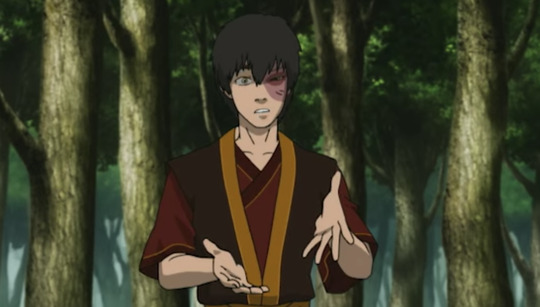
b) There are no buttons
This is picky, but Wikipedia says “Functional buttons with buttonholes for fastening or closing clothes appeared first in Germany in the 13th century.[6] They soon became widespread with the rise of snug-fitting garments in 13th- and 14th-century Europe.” I kinda believe it. If you look closely, characters’ clothes are always tied together or wrapped in some way with a belt. If there are fasteners, they’re braided frog closures that go into a little loop, like the qipao-style dresses women wear in Ba Sing Se, or Zuko’s casual prince’s clothes in the topmost image. Anyways, I don’t think Zuko or Azula or the Gaang would technically button or unbutton anything when they’re changing clothes. Clothing is designed to be tied, not buttoned.
[so much more under cut]
c) This isn’t a real rule, but there’s something called koromogae, or the seasonal changing of clothing in Japan.
This is something I learned when I was writing firebender’s guide, and I just liked the fun detail about there being a strict calendar for when to wear something. I liked the idea of someone like Zuko, who actually spent most of his formative years outside of the Fire Nation, coming home and just suffering mutely through the summer heat because upper class etiquette says no changing into cooler clothes until August 15.
From My Asakusa:
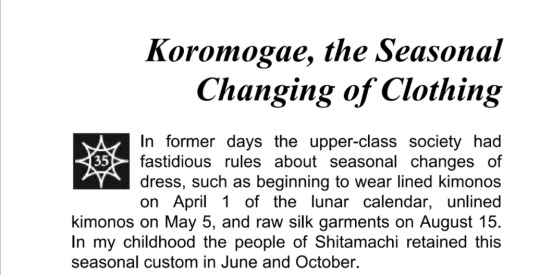
And this website:
Generally, people change from thick, heavy, dark-coloured clothes for winter to thin, lighter, bright-coloured clothes for spring and summer. In traditional Japanese culture, particularly in formal settings such as tea ceremony, it is important to acknowledge the changes of seasons—in such circumstances, not only the patterns and colours of the kimono that are worn but also the utensils and furniture that are used are required to change. By changing their clothing, people notice and appreciate the change of seasons. [Japan Foundation]
Here are some visual guides from the official creators for clothes: (notice how it’s pretty much always left over right)
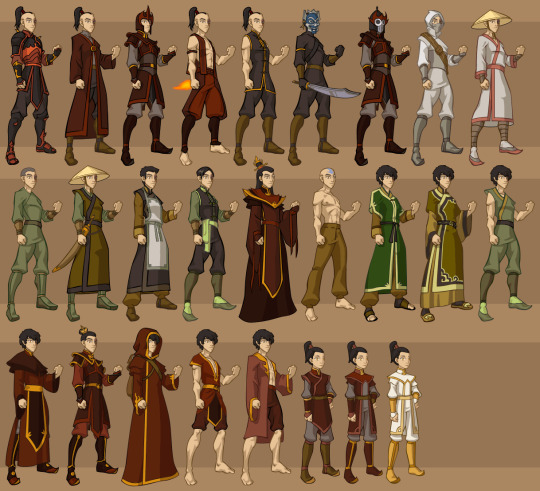
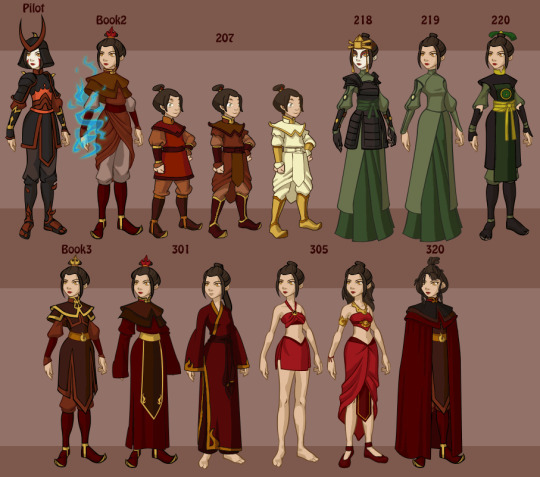
2.FOOD AND EATING
a) Traditional cuisine
It seems like the most common foods in canon are Fire Flakes and meat, to the point where poor Aang had to eat lettuce out of the garbage at some point.
HOWEVER, the Fire Nation seems to basically a big subtropical archipelago, so I would guess that seafood and rice are common. If you want to write about characters eating, a. quick google for “traditional japanese cuisine” would help you come up with a menu really quickly.
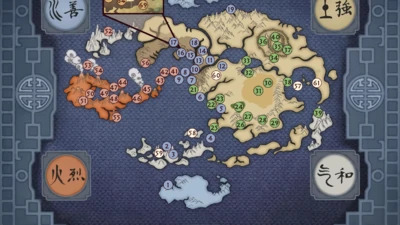
Wikipedia says:
The traditional cuisine of Japan, washoku (和食), lit. "Japanese eating" (or kappō (ja:割烹)), is based on rice with miso soup and other dishes; there is an emphasis on seasonal ingredients. Side dishes often consist of fish, pickled vegetables, and vegetables cooked in broth. Seafood is common, often grilled, but also served raw as sashimi or in sushi.
But before we get too serious, at one point the Gaang eats a “smoked sea slug” (Sokka’s Master)
Oh ATLA, never stop being you.
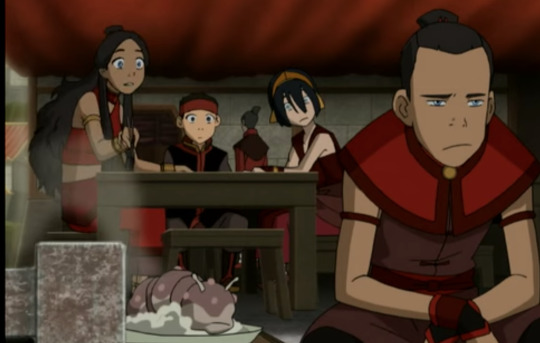
b) Utensils
One thing to keep in mind is chopstick etiquette. Someone like Zuko or Toph, for instance, would have completely internalized all of these.
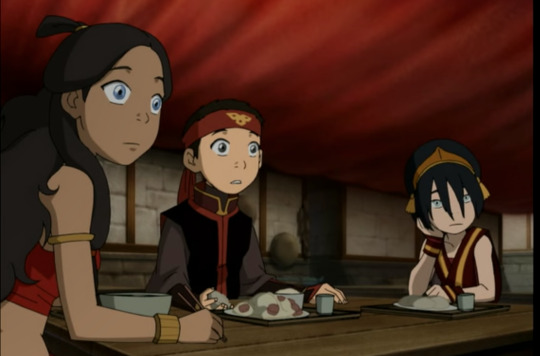
Another thing is that there are no glasses. Cups and bowls are made of ceramic or clay. Let the Gaang show you:
And another note: characters won’t eat “bread” in the European sense, ie. a baked lump of dough. Steamed buns, yes. Fried pancakes made from batter, yes. Flatbreads, okay I’ll give it a pass. Rice or noodles should be the most common carbs of choice.
3.ETIQUETTE
“In the homeland, we bow to our elders” - angry schoolmistress in The Headband.
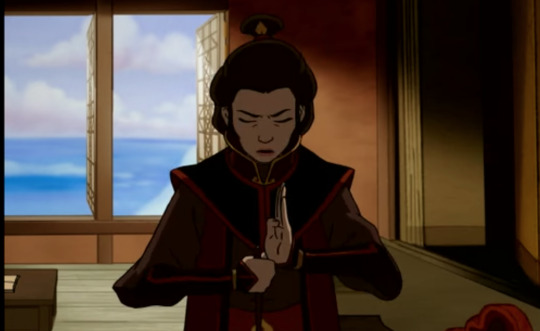
Japan Guide has a list of etiquette rules for visiting Japan, which is interesting but not too necessary to read. In general, based on what The Headband tells us, Fire Nation characters would have been raised with a strong nationalist curriculum that values communal contribution over individualist expression. Even someone like Zuko, who openly rebels against that, probably couldn’t help but be affected by it. In general the Fire Nation seems to have an East Asian-ish set of values. It’s patriarchal, all the positions of authority are filled by men; there seems to be a strong emphasis on patriotism; there’s a sense of diffidence and respect towards one’s elders; and finally, there’s an emphasis on “knowing” one’s place in society and fitting into what’s expected of oneself.
I don’t really know how to describe it, but in China and Japan I sometimes feel like there’s rules for everything, and even people born and raised there acknowledge it could be stifling at times. You could go down a rabbit hole researching points of etiquette (for instance, rules on who has to sit where in group dinners...), but to me the most important thing is acknowledging that Fire Nation has a rigid system of etiquette, and also, they’re an imperialist power who’s pretty prejudiced against foreigners. Poor Aang/Kuzon gets called “mannerless colony slob” just for being slow on the bowing action (!!!)
(in firebender’s guide I had a lot of fun imagining the stupid microaggressions Ambassador Sokka has to face in the Fire Nation, so obviously I’m just biased)
4.WRITING AND DESKS
Characters would probably write on paper, with a calligraphy brush. Not quills or pens -- a brush. Technically, old Japanese and Chinese texts should be written top to bottom, right to left, but the show itself doesn’t do this, so I think you’re fine.
One fun thing about traditional calligraphy is that you don’t use bottled ink. You have something called an ink stone, and then you grind your ink yourself by rubbing the ink stone in a special little dish with a bit of water. In my (very few) encounters with this stuff in the calligraphy lessons of my youth, the ink stones can be plain or have beautiful designs on the side. It looks something like this:
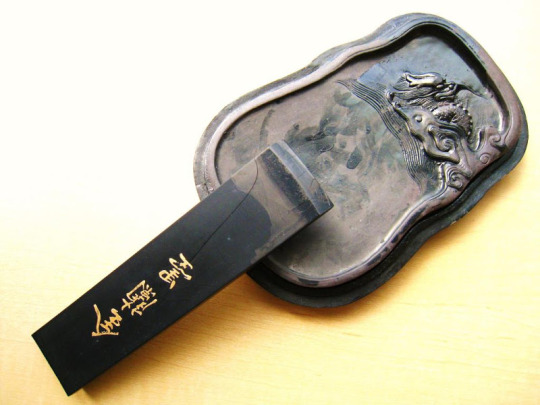
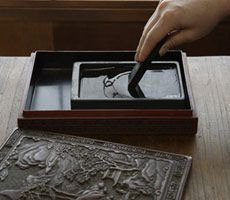
ATLA is an East Asian-ish universe, so characters are likely to be kneeling at a table, not sitting. To demonstrate, here’s my boy Sokka doing his famous rainbow at Piandao’s:
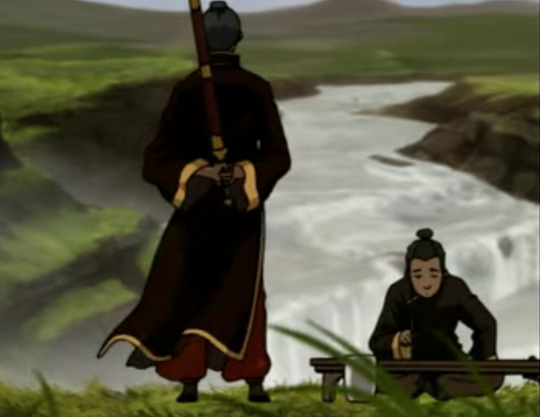
and here’s the war chamber meeting when Zuko speaks out against a general’s plans to sacrifice some soldiers:
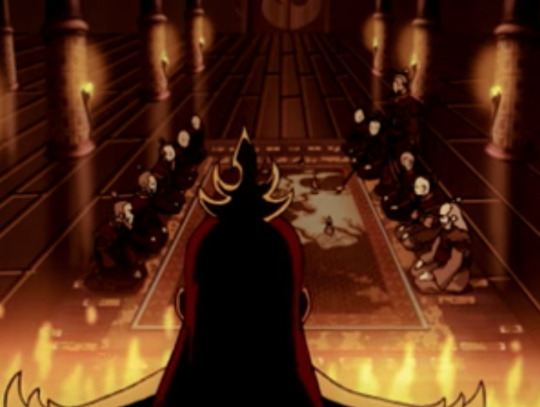
THERE ARE EXCEPTIONS: This is Zuko’s cute little setup when he’s writing his goodbye letter to Mai. In this case he’s writing in a chair and table. It’s possible that some furniture items, like a sitting desk and a bed in a bedframe (not a bedroll or futon) are special royal palace features. Normally in a private setting we see characters sitting on the ground or on a slightly elevated platform with a low table. Maybe Caldera is just different? Or rich people are just different: the Bei Fongs also have a sit-down dining table + chair setup.
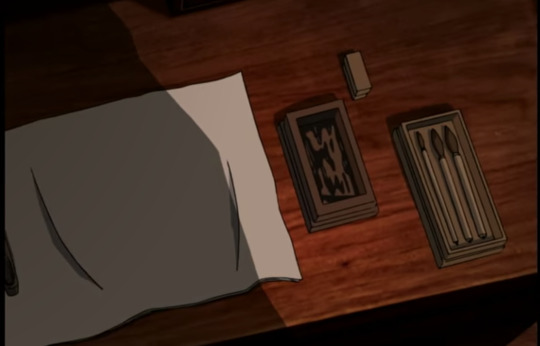
(That little rectangular box is his ink dish!!)
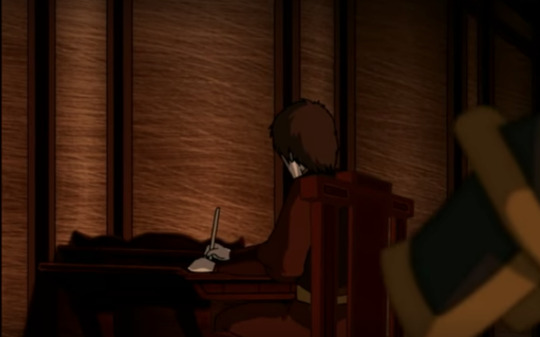
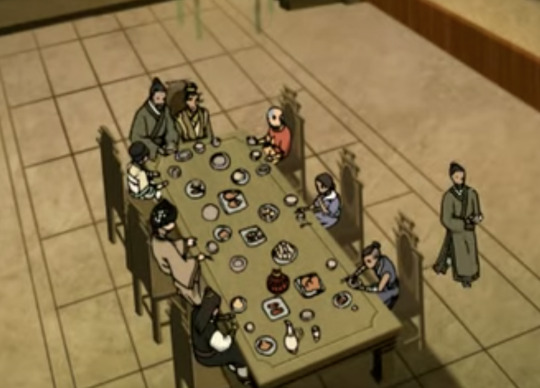
5.A NOTE ON GENERAL CULTURE
It’s worth talking about a few general points of East Asian culture. I can’t claim to speak for ALL of Asia, and I don’t think I should. But I do think ATLA fic writers who want to set something in the Fire Nation should take a few moments to at least skim the wiki pages for filial piety and Nihonjinron (literally, "theories/discussions about the Japanese"). There’s a certain...vibe to...asianness... that I’m not sure I can explain without like, a doctorate degree in sociology.
It’s a bit like gender, I guess. There’s no definitive checklist to what is a woman and what is a man, and we can argue that gender is performative, that it’s a construct, but at the end of the day gender is still (tragically) real in the sense that it still shapes people and affects how we walk and talk and dress and think. Nationality is the same. Obviously, the Fire Nation is a made up place in a made up show, but out of respect to the cultures that inspired it, I do think it’s worth familiarizing yourself with some of these cultures’ codes and values.
Also, ahem, if I can direct you to war crimes in the Japan’s colonial empire. Again, worth remembering that the Fire Nation was an imperalist colonizer too.
I might do a continuation of this post and talk through my more abstract takes about Fire Nation culture - Is Zuko an example of filial piety gone right or filial piety gone wrong? Why I think Zuko’s flashbacks are like, at least part teenage melodrama bullshit (the reason is son preference), how someone like Sokka might be treated once he’s openly Water Tribe in the Fire Nation (probably with racism...), specific aspects of asian homophobia and racism, etc. We’ll see.
This is not a definitive guide. Comments and critique welcome.
If you think there’s a factual mistake, PLEASE hop in my asks and let me know. I also think there’s a huge blind spot in ATLA for South and Southeast Asian representation, so I acknowledge that I can’t speak for all Asians, and there is no such thing as a “pan-asian” identity.
If there’s something else you’re curious about, I’m not a historian or anything, but I like research. Ask me and I’ll try to answer the best I can.
And oh, one last thing, this is how I do research when I wrote firebender’s guide, in case anyone’s interested in learning more (LINK)
3K notes
·
View notes
Text
On Chinese and Eastern Dramatic Acting vs Western
Part 1 Part 2
Mostly in ref to the Untamed/Word of Honor, but applies to a lot of East Asian works-
I’ve been getting the sense that people I know from the west (also being Asian-American myself) often interpret Chinese/Japanese/Korean drama and theatre to be too corny/cheesy/over-acted. A quick search on some internet forums confirms this. Maybe it’s because I used to watch a lot of C-dramas when I was a kid (Legend of the Condor Heroes/Return of C Heroes/Journey to the West/The Reincarnated Princess/etc), I personally did not notice that the acting was over the top.
I don’t really speak for the quality of acting of these actors because I barely follow them in their careers, but I do know that some of them are immature actors or don’t have much formal training (which may cause the cheesiness above). However, Eastern dramatic acting in general does seem like a common complaint, so I decided to look into it - this is all coming from someone who JUST recently got back into watching C-dramas btw, doing my own research so don’t mind me if there’s some incorrect things down here, I am by NO means at all an expert in drama and theater (lol):
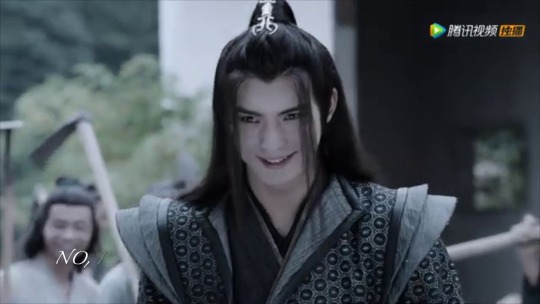
^Villains are often depicted with very exaggerated facial expressions (Above, Xue Yang, The Untamed)
Part 1
1. Chinese concept of mo vs western equivalent of “mimesis” or “imitation”
From this, an excellent chapter on Chinese theatrical concepts vs Western concepts.
Mo plays a significant part in traditional Chinese theatre, usually held to be antithetical to the realism of Western theatre because of its emphasis on theatricality.
Mo means mimesis or imitation, but in a very different sense from the Western concept. One of the first Chinese scholars to use this term, Fu Sinian, used it to compare Western theatre to Chinese theatre:
Presenting a real event and performing an entertaining show are not compatible. The former emphasizes imitation (yige zhong mofang^b); the latter stresses spontaneity and entertainment. The former performance produces a lifelike image; the latter has nothing to produce. The former puts emphasis on the plot; the latter puts emphasis on theatricality. Therefore they are completely contradictory to one another.
This guy actually goes onto critique Chinese theater, saying it should be more like Western realism, so that there will “be no singing, and the acting will imitate people’s real gestures.” However! Other Chinese critics tried to approach Western vs traditional Chinese drama as two DIFFERENT but still valid forms of art. For example, Yu Shangyuan (1927) said western performance is “writing realistically” (xie shi) and chinese performance as “writing suggestively” (xie yi). Western dramas really rely on an accurate/semi-accurate representation of life and realism. Traditional Chinese drama and acting relied on the “symbolic and imaginative.”
Then what is mo? It is the emotional display, the emotional revelation, that is shown on stage. Starting from the Yuan dynasty, the Chinese drama was thought to be a continuation of poetry rather than its own independent stage art.
Poetry is where the intent of the heart goes. Lying in the heart, it is “intent”; when uttered in words, it is “poetry.” When an emotion stirs inside, one expresses it in words; finding this inadequate, one sighs over it; not content with this, one sings it in poetry; still not satisfied, one unconsciously dances with one’s hands and feet. [anonymous, 1975, from Shi Daxu 200 BCE]
Chinese drama with dancing and singing, was the most expressive product of poetry. The importance of mo cannot be stressed enough - it is the measure by which traditional Chinese drama was judged, how well this drama make you feel? Love, pain, loss, guilt, happiness? Plot becomes something that doesn’t matter as much (more on that later).
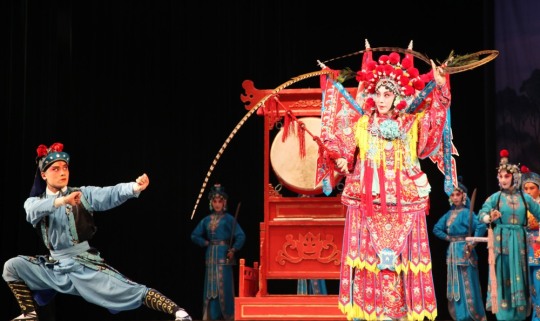
^Beijing/Peking Opera - highly stylized, emotive, “unrealistic” performances
To emphasize how central and important this concept is, it’s thought that a good Chinese playwright never fails to “seize a highly dramatic scene to stage an elaborate presentation of an emotional state.”
Love is of source unknown, yet it grows ever deeper. The living may die of it, by its power the dead live again. [Peony Pavilion, Mu dan ting]
This quote really shows how important it was to show these emotions on stage, to inspire the audience to feel deeply. Chinese critics believed that the best part about drama was how efficient it is to display emotion. Playwrights should “depict extreme bitterness, extreme happiness, extreme silliness, and extreme sobriety; imitate these feelings to the utmost (miao mo jin xing^p).”
Such performances are not necessarily accurately mimicking reality, but they are obtained through the “revelation” of a character’s internal emotional world.
2. Mo vs the depiction of reality or theatrical truth
The Chinese concept of aesthetic truth relates a lot to theatrical truth. In a lot of traditional Chinese art, painting, poetry, etc, aesthetic truth is not empirical, and doesn’t have to be accurate to life, or realistic. It’s a “truth that lies beyond mere superficial likeness.”
To the Chinese artist, an accurate resemblance between art and reality is not only superficial but often distorting. Chinese artists hold a dialectical view on the “form” (xing) and the “spirit” or “content” (shen) of an artistic object. According to them, xing and shen are not always complementary. On the contrary, they often stand in opposition to one another. (referenced in the chapter above)
Traditional Chinese artists would rather represent the object with the wish that their representation matches its spirit, or abstract identity, than its actual form because a “photographic image is a shallow image.” It’s easy to draw a picture of something realistically, but it’s much harder and more satisfying to depict its nature, its feeling, its spirit.
This also naturally affects theater and dramatic performances.
Dramatic writing can be divided into two types: “a painting-like work” or a “transformed work,” in which the latter has higher artistic value because it reaches more towards the essence of dramatic object. Realistic imitations are fine, but they’re not really enough to reveal the mo or true feelings of something.
In addition, traditional Chinese dramatists believe that “all dramas are nothing but allegories. One need not ask about their origins in actual life.” You might be able to see, then, that these older playwrights and critics really fancied the overdramatic depictions of emotions.
a. The Chinese notion of theatrical truth/aesthetic truth vs European
Onto what we, as part of the Western audience, are more used to:
For Italian neoclassical critics, the pleasure of a drama hinges on how accurate, how realistic, the depiction is. Castelvetro, the leading Italian Neo-Classical critic and creator of the concept of “the three unities,” claims thus:
We cannot imagine a king who did not exist, nor attribute any action to him.
Another Italian critic, Robortellus, said that a creative/imaginative story with no “verisimilitude” (truthfulness, in this context, realism) is less appealing than one that imitates a real-life event:
Thus if a tragic plot contained an action which did not really take place and was not true, but was represented by the poet himself in accordance with verisimiltude, it would perhaps move the souls of the auditors, but certainly less.
So basically, it’s fundamentally the opposite of Chinese theater. Italian dramatic works prized being realistic, being properly adapted from reality and real events. Chinese dramatic works, however, enjoyed the emphasis on heartfelt emotional demonstrations, or mo. Even in critical writings, the word “truth” is used, but it is usually used to modify the word “heart” or “emotion.” It is very concerned with the internal, the truthfulness of heartfelt emotional expression.
Taken these contexts, you can see why the Chinese stage/dramas are wholly “unreal” as Tao-Ching Hsu puts it. Everything, the makeup, the costumes, the props, is expressive and suggestive rather than imitative.
b. Bejing/Peking Opera, jingju
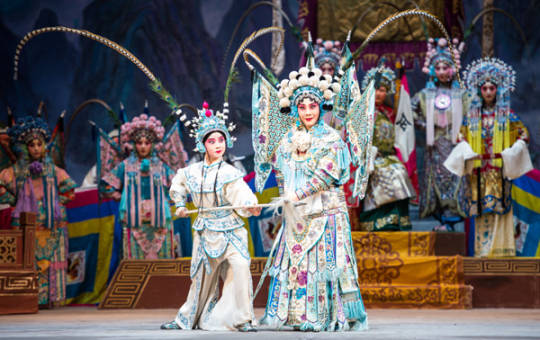
A famous example is the Beijing/Peking Opera, jingju. The makeup and costumes themselves are fantastical representations. The colors and patterns suggest different moods, temperaments, characters, and even changes in emotions. Actors would make distinct movements to depict distinct emotions with varying levels of energy. The stage itself may be sparse, because it is not as important as the expression of emotion and drama.
The stage is sparse not because of the lack of technology or funding, but because it leaves room for the actor themselves to fully express their internal thinking/feeling/emotions. Characters can cross hundreds of miles in a few steps or may take the whole stage to cross a supposed road. This representation looks “unreal” to a realistic-minded audience, but it is very genuine to a Chinese audience.
Summary (so far)
This crucial understanding of the concept of mo (the emotional revelation), and the way traditional Chinese drama depicts life and stories, informs how their modern works are also portrayed. Coming from a Western dramatic background, where realism and plot are the most important aspects of a work, it can be very confusing, right? Even Chinese scholars began to judge their own dramatic works through a Western lens.
How does this traditional background affect modern Chinese dramas and works? I think it still has a very large effect, even though much of Western ideals about dramatic works have been heavily integrated into modern Chinese dramas.
Part 2: On Theatricality and how it transfers into Chinese Cinema
#cdramas#theater#acting style#beijing opera#the untamed#word of honor#kdramas#jdramas#theatricality#east asian cinema
129 notes
·
View notes